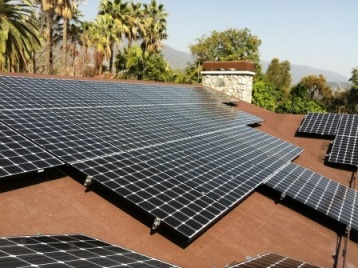Welcome to the
Run on Sun Monthly Newsletter

In this Issue: |
June, 2015
Volume: 6 Issue: 6
Roofing Reality Check. Top 3 Considerations for SolarSo, you are considering a solar power system for your home or business... and why not, given the myriad of social, environmental and economic benefits! But how do you know if your roof is a good candidate? This is one of the top questions to consider carefully before investing in solar.
Run on Sun uses LG panels which are about 65 x 40 inches and can be placed in either a portrait or landscape layout. Panel energy ratings vary, 280-305 watt panels are currently available from LG. For an average home (5 kW) that means you would need around 16-18 panels to offset the bulk of your electricity. Another limitation is that the fire code requires three feet of clear space from all ridges. If you have an irregular shaped roof with many valleys and peaks it may make the layout very challenging. Given that the panels are rectangular and racking is mounted parallel to the roof, rectangular spaces are ideal.
3. Should I re-roof my house before adding a solar system?This may be the most important and frequently overlooked question to consider when researching if solar is right for you. Part of what makes solar a great investment is the 25+ year lifetime of the system. But if you have to re-roof during that time there are added costs to remove and re-install the system. If you are planning to re-roof during the lifetime of your solar array be sure you select components, such as the racking system, from companies that, A. will still be around 15-25 years later, and B. will be able to provide compatible replacement parts when pieces are lost during removal and re-installation. Avoid newer companies testing out "state-of-the-art" racking systems and cheap companies banking on the solar boom alone For this reason we always ask owners the age of their roof. In southern California, a roof over ten years old should get a makeover before installing solar. If you are unsure of the condition, it is a good idea to have a professional roofer take a look and give you an expert opinion. Sometimes solar contractors can offer this as part of their free assessment. (Run on Sun works with a very reliable roofer who is happy to take a look at any roof in question!) If the roof still has some life left in it but not enough to outlast the solar system you could re-roof only the area where the solar array will cover and plan to do the rest later. An added benefit is that the solar panels will actually protect your roof from the elements, helping it to last longer. Unfortunately, you will likely be able to find someone willing to put solar on your roof even if it isn't a good candidate. But if they aren't discussing the above issues with you, then red flags should be flying! To ensure you get the best investment possible, do your research, take a good long look at your roof, and discuss all of your concerns with your solar contractor. |
“What if my roof is shaded?”
Get your copy of
Commercial Solar:
Step-by-Step
from
Run on Sun
Founder & CEO
Jim Jenal

Now available on Amazon.com
in both
Print & Kindle versions.
Bonus - Buy the Print version…
Get the
Kindle version for Free!
Commercial Solar:
Step-by-Step
from Run on Sun
Founder & CEO
Jim Jenal

Now available on Amazon.com
in both Print & Kindle versions.
Get the Kindle version for Free!
Are Pasadena's Electric Rates Regressive?Recently a potential client was asking us about an oddity in their Pasadena Water and Power (PWP) electric bill. PWP has a tiered rate structure, but the most visible component of that tiering, the Distribution charge, steps up above 350 kWh of usage in any one month, but it steps down above 750! Which lead us to the question, are PWP's electric rates regressive? Designed that wayPWP's Residential rate structure, like many utility tariffs, is a model of complexity. On your bill there are a number of obvious charges, and a few that are not so obvious. The obvious ones are on the right-hand-side of the bill and include a Customer charge, a Distribution charge, a Transmission charge, and an Energy charge. (The not-so-obvious charges include those related to public benefit programs and paying to put power lines underground.) All of these obvious charges are tied to the customer's usage, but only one, the Distribution charge, is tiered. At or below 350 kWh of usage per month, the customer pays just 1.5¢/kWh. Between 351 and 750 kWh of usage the Distribution charge increases dramatically all the way up to 11.65¢/kWh, nearly an eight-fold increase! Ok, the whole point of a tiered rate structure is to discourage higher use by making you pay more as your usage increases. But PWP's rate then does something truly odd - above 750 kWh/month the rate comes down, dropping from 11.65¢/kWh to just 8.5¢/kWh! What sort of an incentive is that? But is it regressive?That rate design is certainly counter-intuitive, to say the least, but is it regressive? In other words, is there a point at which a large residential user ends up paying less per kWh than does someone who uses less? To find out, we modeled daily usage from 10 kWh/day all the way up to 60 kWh/day. As a reference, a typical Run on Sun client in PWP's service area averages around 25 kWh/day. Since the Transmission and Energy charges are adjusted higher in the summer months, we broke out the overall rates seasonally as well. Here are our results (click for larger): How does this relate to solar? Well, if your usage is above 20 kWh/day you are spending at least 20¢/kWh whereas the cost of a solar power system will be less than half of that! So yes, in PWP territory - and particularly while they still have rebates in place - installing solar will still pay you big dividends. |
Solar Impulse Making HistoryThe solar-powered, around-the-world flight of the Solar Impulse II has resumed on the longest leg of the mission, from Nagoya, Japan to Hawaii. This present leg, of some 8,340 km (or 5,182 miles), requires the lone pilot - André Borschberg - to maintain flight for nearly five days! As of this writing, Mssr. Borschberg is into his 49th hour of solo flight and is 40% of the way to Hawaii.
That is a whole lot of open ocean between SI and Hawaii. Remember that this flight was originally planned to span from China to Hawaii, but dangerous weather in the Pacific forced the hastily scheduled landing in Nagoya, which resulted in some damage to the aircraft that had to be repaired before the flight could resume. (The aircraft is facing West in this screen capture because it is in a holding pattern while ground control assesses whether and when a cold front will clear from their intended path.) Hopefully our next Newsletter will feature a story recounting the successful conclusion to this amazing mission. Watch this space! |




